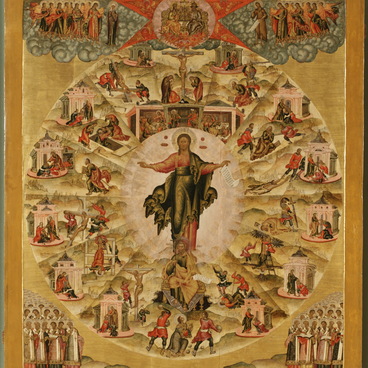The icon Annunciation with Akathist features the apparition of Archangel Gabriel to the Virgin Mary. He announced the future birth of the Son of God, which was predicted by the Prophets. The apparition is mentioned in the New Testament (in the Gospel of Luke) and in the apocryphal texts.
Annunciation with Akathist
Время создания
The first half of the 16th century
Размер
120x92 cm
Техника
Tempera
Коллекция
Выставка
2
Открыть в приложении#1
Unknown author
Annunciation with Akathist
#7
#8
The Annunciation is one of the most popular subjects reflected in Christian art since the 4th century. The archangel appeared to the Virgin Mary with the good news when she was working on the shroud for the Jerusalem temple; she had received the task to spin the purple and scarlet colors by drawing lots. Our Lady is depicted sitting on the throne, with her head inclined in submission. The angel is moving towards the Virgin Mary. He is stretching out one arm in a blessing gesture and holding a rod, epitomizing the heavenly messenger, in the other hand. We can also see the figure of a maid seated behind the spinning wheel at the Virgin Mary’s feet. Some Russian and Greek icons of the 14-17th centuries feature this character.
#9
The central composition of the icon, the centerpiece, is surrounded by 24 markings, picturesque miniatures explaining the main subject. They illustrate the solemn church hymn, the Akathist of Our Lady. Saint Romanos the Melodist, the Byzantine hymnographer who lived in the 6th century, is considered to be the author of the hymn. The first half of the text of the Akathist is dedicated to the events from the Gospel: the Annunciation, the Nativity of Christ, the adoration of the Magi, the Candlemas (the Presentation of Jesus in the Temple). The glorification of Christ and the Virgin Mary alternate in the second part. The miniatures also depict Christ carrying his Cross to Golgotha and the worshipping of Our Lady’s image. This is the first known icon featuring the Annunciation as the centerpiece, surrounded by Akathist markings.
#10
The icon featured in the exhibition was presumably painted by a Moscow artist who worked in Yaroslavl. It was painted on a linden board which consisted of three parts fastened together with sunken keys. The color range of the work is based on contrast: the architectural pieces are painted in sparkling light shades, while the faces and the figures of the saints are dark, mostly in shades of brown. The Annunciation with the Akathist was part of the iconostasis of the Monastery of the Transfiguration of the Savior in Yaroslavl.
#11
Yaroslavl Museum Reserve
читать дальшескрыть
00:00
00:00
1x
Annunciation with Akathist
Время создания
The first half of the 16th century
Размер
120x92 cm
Техника
Tempera
Коллекция
Выставка
2
Открыть в приложении
Поделиться



